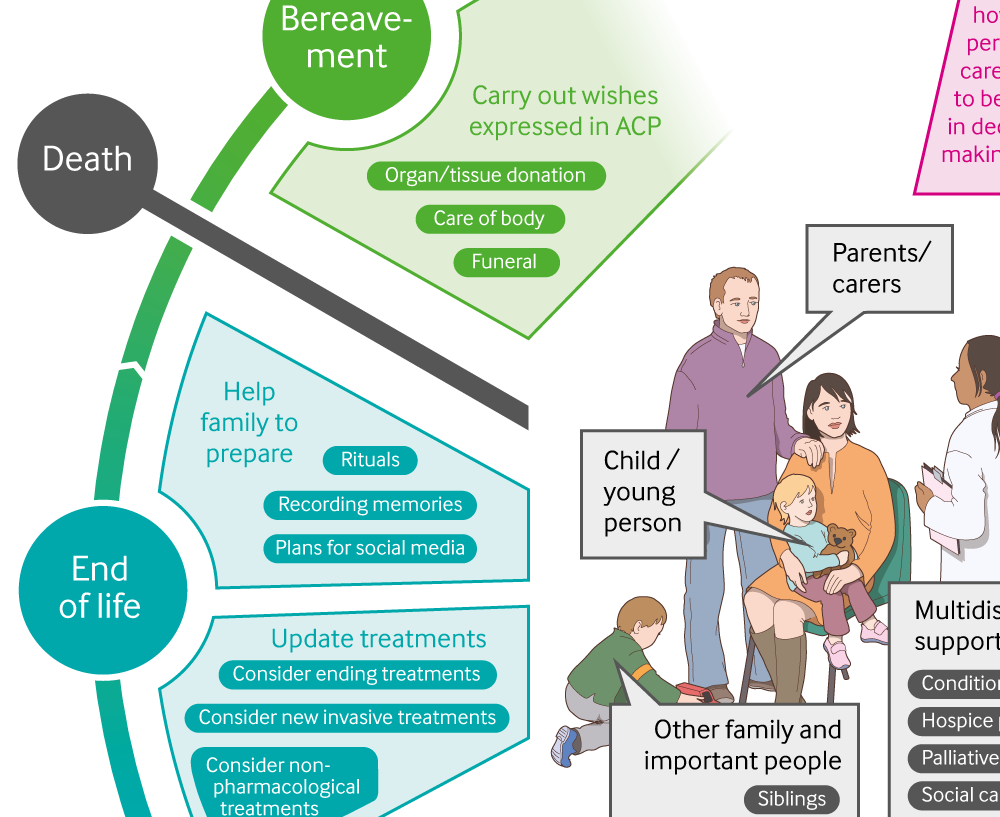End of life care for infants, children and young people with life limiting conditions: summary of NICE guidance
BMJ 2016; 355 doi: https://doi.org/10.1136/bmj.i6385 (Published 08 December 2016) Cite this as: BMJ 2016;355:i6385
Infographic available
Click here for a visual summary of the recommendations for end of life care for children and young people, including likely needs of young person and their family, professional involvement required, and advance care planning.

Chinese translation
该文章的中文翻译
- Gemma Villanueva, senior systematic reviewer1,
- M Stephen Murphy, clinical advisor1,
- David Vickers, chair of guideline committee, consultant paediatrician and medical director2 3,
- Emily Harrop, deputy chair of the guideline committee, consultant in paediatric palliative care4 5,
- Katharina Dworzynski, guideline lead1
- 1National Guideline Alliance, Royal College of Gynaecologists and Obstetricians, London NW1 4RG, UK
- 2Cambridgeshire Community Services NHS Trust, St Ives PE27 4LG, UK
- 3East Anglia’s Children's Hospices, Milton CB24 6DF, UK
- 4Helen & Douglas House, Oxford OX4 1RW, UK
- 5Oxford University Hospitals, Oxford OX3 9DU, UK
- Correspondence to: K Dworzynski kdworzynski{at}rcog.org.uk
What you need to know
Involve children and young people with life limiting conditions and their parents or carers in decision making and care planning
An advance care plan is a core element of a child’s or young person’s end of life care
Be aware that other family members such as siblings and grandparents, and others (such as friends, boyfriends or girlfriends) may need support
Name a medical specialist who leads on and coordinates the child or young person’s care
Decisions about care should always consider what it is the best interest of the child
Children and young people can have a wide range of life limiting conditions and may sometimes live with such conditions for many years. This guideline recommends that end of life care be managed as a long term process that begins at the time of diagnosis of a life limiting condition and entails planning for the future. Sometimes it may begin before the child’s birth. It is part of the overall care of the child or young person and runs in parallel with other active treatments for the underlying condition itself.1 Finally, it includes those aspects related to the care of the dying.
This guideline was commissioned with the aim to standardise end of life care for infants, children, and young people living with a life limiting condition, and thus promote equity and consistency. Important themes are to involve children and young people and their parents or carers in decisions about their care, facilitate their care in their preferred location (most likely home), and plan for day and night care.
This article summarises the most recent guidance from the recent National Institute for Health and Care Excellence (NICE) on the planning and management of end of life care in infants, children, and young people.2 For a visual summary, please …
Log in
Log in using your username and password
Log in through your institution
Subscribe from £173 *
Subscribe and get access to all BMJ articles, and much more.
* For online subscription
Access this article for 1 day for:
£38 / $45 / €42 (excludes VAT)
You can download a PDF version for your personal record.
